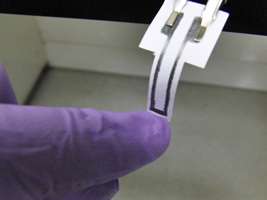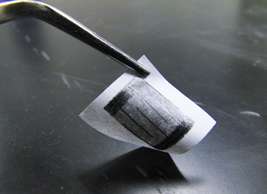Detecting chemicals, measuring strain with a pencil and paper

(Phys.org) —Sometimes solving a problem doesn't require a high-tech solution. Sometimes, you have to look no farther than your desktop.
Three students from Northwestern University's McCormick School of Engineering—an undergraduate, a master's student, and their teaching assistant—have proven that pencils and regular office paper can be used to create functional devices that can measure strain and detect hazardous chemical vapors.
A paper describing their findings, "Pencil Drawn Strain Gauges and Chemiresistors on Paper," was published January 22 in Scientific Reports, an open-access journal from the Nature Publishing Group.
The project originated in fall 2011 in McCormick's Introduction to Conducting Polymers course (MSE 337) during a discussion about the conductive properties of graphene, a one-atom thick layer of carbon that can be parsed from regular pencil lead. (A misnomer, pencil "lead" actually comprises graphite in a clay binder.)
"When you draw a line on a piece of paper, the graphite may shed numerous graphene sheets," said Jiaxing Huang, associate professor of materials science and engineering who taught the course and who was a co-author on the paper. "A student asked, 'Can we use that graphene for something?' That started an exploration of what pencil traces can do."
One team of students—including lead authors Cheng-Wei Lin (MS materials science '13) and Zhibo Zhao (BS materials science '13)—started by measuring the conductivity of a pencil trace on paper, then used the traces to create a rudimentary electrode. They learned that curling the paper in one direction increased the trace's conductivity by compressing the conductive graphene particles. Curling the paper in the other direction loosened the graphene network and decreased conductivity.

The students then turned to the traces of a bendable toy pencil. (These novelty pencils are flexible because the graphite is mixed not with clay, but with a polymer binder.) Again, conductivity could be increased and decreased by manipulating the paper, but the students found it also was affected by the presence of volatile chemical vapors, such as those from toxic industrial solvents.
When the chemical is present, the polymer binder absorbs the vapors and expands, pushing the graphene network apart and decreasing conductivity. The conductivity decreased the most in the presence of vapors that are more readily absorbed by the polymer binder.
These types of chemical sensor—also called "chemiresistors"—are key elements in "electronic noses" for detecting toxic chemical vapors. In creating chemiresistors, researchers often use more expensive materials, such as networks of carbon nanotubes or metal nanoparticles, and need to disperse them in polymer matrix to form a network.
"Now our students showed that this can be done simply with a pencil and paper—and it works," Huang said. "This is a great example showing how curiosity leads to innovative work."
Other applications of the pencil-and-paper technology could be more unconventional. "It could help to inspire some new form of art," Huang said. "Perhaps one can make 'smart' and interactive drawings, in which the art itself is the circuitry and can respond to the environment."
In addition to Lin, Zhao, and Huang, Jaemyung Kim (PhD materials science '13), who served as teaching assistant for the course, co-authored the paper.
More information: www.nature.com/srep/2014/14012 … /full/srep03812.html
Journal information: Scientific Reports
Provided by Northwestern University



















